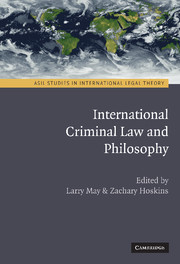Book contents
- Frontmatter
- Contents
- List of Contributors
- Introduction
- PART ONE SOVEREIGNTY AND UNIVERSAL JURISDICTION
- PART TWO CULTURE, GROUPS, AND CORPORATIONS
- 4 Criminalizing Culture
- 5 Identifying Groups in Genocide Cases
- 6 Prosecuting Corporations for International Crimes: The Role for Domestic Criminal Law
- PART THREE JUSTICE AND INTERNATIONAL CRIMINAL PROSECUTIONS
- PART FOUR PUNISHMENT AND RECONCILIATION
- Index
- References
5 - Identifying Groups in Genocide Cases
Published online by Cambridge University Press: 19 January 2010
- Frontmatter
- Contents
- List of Contributors
- Introduction
- PART ONE SOVEREIGNTY AND UNIVERSAL JURISDICTION
- PART TWO CULTURE, GROUPS, AND CORPORATIONS
- 4 Criminalizing Culture
- 5 Identifying Groups in Genocide Cases
- 6 Prosecuting Corporations for International Crimes: The Role for Domestic Criminal Law
- PART THREE JUSTICE AND INTERNATIONAL CRIMINAL PROSECUTIONS
- PART FOUR PUNISHMENT AND RECONCILIATION
- Index
- References
Summary
The [ICTR] Chamber notes that the Tutsi population does not have its own language or a distinct culture from the rest of the Rwandan population. However, the Chamber notes that there are a number of objective indicators of the group as a group with a distinct identity. Every Rwandan citizen was required before 1994 to carry an identity card which included an entry for ethnic group… The Rwandan Constitutions and laws in force in 1994 also identified Rwandans by reference to their ethnic group… Moreover, customary rules existed in Rwanda governing the determination of ethnic group, which followed patrilineal lines of heredity… The Rwandan witnesses who testified before the Chamber identified themselves by ethnic group… Moreover, the Tutsis were conceived of as an ethnic group by those who targeted them for killing.
Currently in the international law of genocide, there is a debate about whether groups should be defined objectively, on the basis of criteria that anyone can apply, or subjectively, in which only the perpetrators decide who is a member of a group and even what are relevant groups. Genocide is defined as “the intent to destroy, in whole or in part, a national, ethnical, racial, or religious group, as such,” so it matters quite a bit how groups are identified. Indeed, in the Rwanda genocide there was, and remains, much dispute about whether the victim group, the Tutsis, was indeed a group of the sort that could be the subject of genocide and hence a group that could seek redress in international law for the harms that the Hutus perpetrated against the Tutsis.
- Type
- Chapter
- Information
- International Criminal Law and Philosophy , pp. 91 - 107Publisher: Cambridge University PressPrint publication year: 2009
References
- 1
- Cited by



